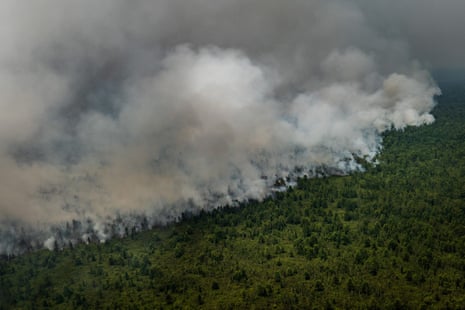The Indonesian government is deploying artificial rains ahead of the dry season’s peak as the country attempts to prevent a repeat of the devastating fires that ravaged millions of acres of forests and land last year.
Toxic haze was spewed across south-east Asia, forcing the closure of airports and hundreds of schools, and prompting a diplomatic spat with Malaysia in September last year.
The fires destroyed crucial habitats, contributed to a major surged in respiratory illnesses, and are thought to have cost the economy at least $5.2bn.
There are fears that efforts to prevent similar fires this year could be undermined because the country is occupied fighting an escalating coronavirus outbreak.
The environment and forestry minister, Siti Nurbaya, said that artificial rain had already been deployed successfully in fire-prone areas over recent months, according to reports in the Jakarta Post. Usually, this process involves sending salt flares into passing clouds to trigger rainfall.
‘‘We are usually rather worried about the weather development in June or during Lebaran [Idul Fitri]. We are now a little relieved but we need to remain alert for the second critical phase at the peak of the dry season in August. All relevant parties must increase their vigilance,’’ Siti said.
Law enforcement agencies are also stepping up their work, according to officials, though others warn legal powers are still far too weak.
Forest and peat fires are often linked to slash-and-burn practices, where land is cleared for palm cultivation. Environmental groups have previously accused authorities of failing to impose serious penalties on pulpwood and palm oil companies that have had fires on their land.
Since 2015, 50 civil lawsuits have been filed against firms for causing fires but, of these, just 11 have reached a final verdict, according to figures reported by the Jakarta Post. In total, the state is owed a total of 19.4tn rupiah(US$1.36bn), but has so far received less than Rp1tn.
